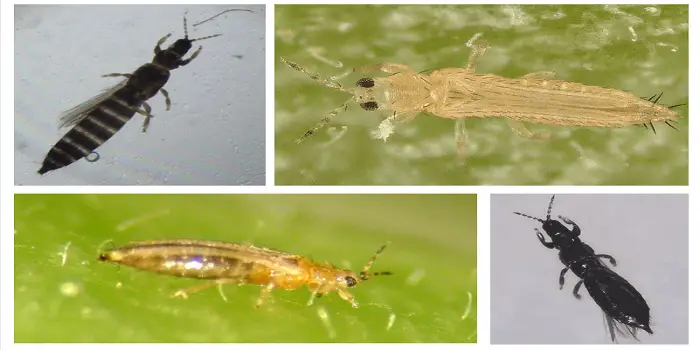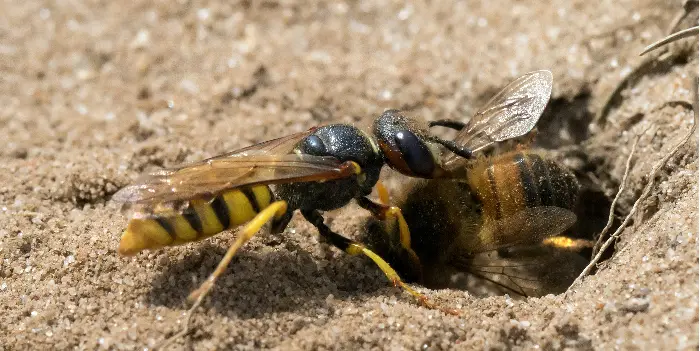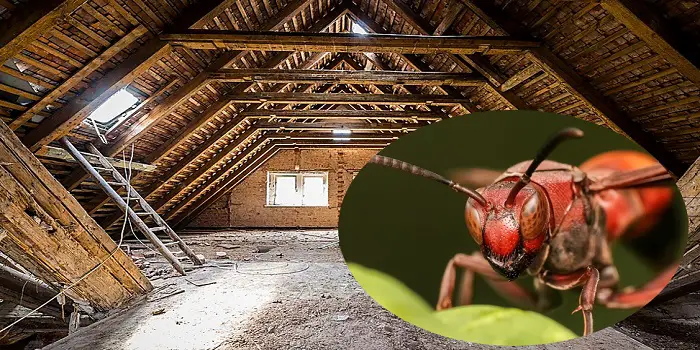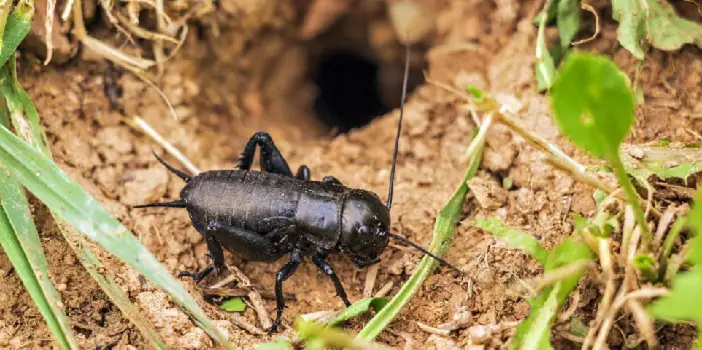
One of the most common pests found in gardens and greenhouses, thrips, are tiny insects that are no more than 1/25th of an inch in length.
Their small size makes them hard to see. Combined with their agility, speed, and ability to fly, catching thrips is even more difficult.
However, the damages that thrips can cause in the home are unmistakable.
And while thrips are mostly found in outdoor locations, they have no issue with coming inside your home and feeding on the potted plants.
They leave behind indoor plants with jagged scars and sometimes a splotchy appearance as they consume the leaves and stems.
The worst part is, because they are community insects, they will feed in large numbers, which can consume a plant quickly.
So, keeping these tiny insects away from your home and young plants is most important if you do not want to compromise your home and garden’s beauty.
Different Ways to Get Rid of Thrips
The good news is that thrips can be eliminated using common household materials with natural means.
This means that if you find these pesky insects in your home, you do not have to purchase insecticides or other poisons which may also harm family and pets.
However, if you find that the following natural methods do not work, then call a professional exterminator who can do the job.
1- Inspect Indoor Plants
Thrips can infest your home and can multiply fast once they manage to get inside.
They can find their way into your home primarily through indoor plants when they are brought inside.
Once they get inside, they can nest on these indoor houseplants to suck the nutrients and breed.
Once they breed and larvae become adults, they can quickly multiply and infest your whole home.
It, therefore, is recommended that you inspect every plant you plan to bring inside your home.
Also, check these at-home plants regularly for infestation from time to time.
2- Diatomaceous Earth
This seemingly harmless-looking substance will dehydrate thrips and cause them to die rather quickly.
Just sprinkle the product over the soil of the plant.
Any insect that comes into contact with it will be cut and dehydrated rather quickly.
The best place to sprinkle it around the plant stem itself is where many immature thrips will gather.
While Diatomaceous earth is generally harmless to people and pets when used in small quantities, you should still wear gloves when handling the product.
Keep your kids away as well since the substance can irritate them.
3- Essential Oils
Many essential oils are both organic and kill at home and thrip quickly.
You can mix one to two drops of essential oils per gallon of water.
Pour the mixture into a spray bottle and use it where needed.
Peppermint oil is one of the most effective and offers a pleasing scent once applied.
In addition, the essential oil is safe and can be used liberally around the home.
Of all the essential oils, there is one that does work more effectively than most of the others. It is called Neem oil.
4- Neem Oil
This is an essential oil that is quite e good at killing thrips along with many other small insects.
Neem oil is inexpensive and does no harm to those living inside your home.
Just a couple of drops per gallon of water is enough of a mixture to do the job.
Pour it into a spray bottle and use it directly against the thrips.
They will die quickly once exposed.
While most plants are resilient to neem oil, you may want to test it on a leaf first to see if it is sensitive before spraying it on your indoor plants.
If you see any dead thrips, be sure to wash the plant off with water so as not to attract other bugs which eat dead insects.
One issue with Neem oil is that it should not be exposed to direct sunlight when applied to outdoor plants.
The UV rays will heat the Neem oil and burn the plant.
So, wait until after sunset before spraying your outdoor plants, which gives time for the Neem oil to be absorbed or evaporate.
5- Pyrethrin
One of the most popular pesticides is pyrethrin.
It is easy to obtain and is quite effective in killing thrips and other unwanted insects.
Plus, it’s short-term in nature, meaning the pesticide will dissolve and disappear, not harming the plants, pets, or people after a pre-set period.
Remember that pyrethrin is the ingredient in short-term pesticides, so you will have to read the labels to find it.
It is often used in organic or all-natural pesticides, so be sure to look at the ingredients.
The main advantage of this pesticide is that it works quickly to eliminate thrips.
But if you have kids or pets around the home, you may want to try an alternative if you are concerned about using pesticides.
6- Soapy Water
Mix a few drops of dish soap per one cup of water.
Pour the mixture into a spray bottle and then spray it at the thrips, the plants, and any surfaces where you see the little flies.
Before spraying the mixture on plants, you might want to limit the exposure to one leaf and see if it does any damage.
However, you can spray it on surfaces that will kill the thrips rather quickly.
Of course, the thrips breed rather quickly as well, so you will need to reapply the soapy water every day until there are no more thrips around.
Once you have covered the main areas, look for entrances around the home and apply the mixture to prevent them from coming inside.
TIP: Although any dish detergent will work, products like Dawn can also be used to make your DIY insecticidal soap that can keep the bugs away.
7- Sticky Traps
If you want to maximize safety, then sticky traps are the way to go.
You can purchase them inexpensively or make them yourself.
The advantage of sticky traps is that they do not use any poisons or liquids, for that matter.
The black thrips inside your home can easily get stuck in the trap and die rather quickly.
You can then dispose of the trap when desired and replace it as needed.
To catch thrips in your home, be sure to use blue traps as they are attracted to that color.
Place the traps around your indoor plants and areas where thrips tend to fly around.
8- Water
For your outdoor plants, spraying them with water every day will destroy the thrips.
You can even bring your indoor plants and spray them off.
Use enough pressure to wash away any thrips from the plants, but not so much as to damage the plants.
The thrips will drown because of the water, and the spray will also wash away the dead ones.
You should repeat the process for at least a few days to ensure that all the thrips are gone.
9- Natural Predators
If you are looking for other, natural ways to keep thrips away from your home and garden, try using bugs that eat thrips, such as ladybugs.
They will not harm your plants, but they will eliminate the thrips.
Plus, you can attract pirate bugs and lacewings which also consume thrips and other harmful insects.
What do Thrips Look Like?
Although identical, thrips are not earwigs.
They are different and will most likely do damage to household plants differently.
There are thousands of different species of thrips, but they do have some common features when talking specifically about thrips.
Most notably, they can fly and will often be found hanging around plants in your yard or garden area.
Other features include the following…
- They are Small, Agile, and Fast
- They have a Long, Slender Body with Feathery Wings
- Their Common Colors include Black, White, and Green
Some thrips are also transparent, depending on the exact species and their age.
However, it is quite possible that you have many thrips in your yard but have never seen one because they are so small.
The ones that are normally seen are black and resemble a small house fly.
Immature thrips have yet to develop their wings and are normally yellow in color until they become adults.
Where Do Thrips Like to Live?
If you are looking for thrips, the first place to go is the plants inside and outside your home.
Plants that flower and have lots of sap available are prime locations for thrips.
Given their sheer numbers, thrips will often find their way into your home.
This is generally because a pet, a child, an adult, or taking in your laundry will provide them a ride inside your house.
And since all that is needed is a few thrips to get started, it will not be long before they breed in considerable numbers to fill up your home.
Do thrips lay eggs in soil?
The adult thrips mate before winter.
And the females lay up to 80 eggs per clutch by inserting their eggs into the plants’ flowers, leaves, or stems.
Adult thrips usually do not lay eggs in the soil, but as the eggs hatch within a few days, the wingless larvae (nymphs) can fall into the soil and will feed on organic plant matter and sap.
After the larvae turn into adults, they develop wings and will fly out of the soil.
Also, adults and pupae overwinter in the soil to protect themselves from the cold.
Due to this whole process, it may appear as if thrips lay eggs in the soil.
Where can you find them most?
Thrips are especially fond of and are attracted to colors like blue, yellow, orange, and white.
Therefore, colorful flowering plants like ficus, roses, houseplants, orchids, dandelions, daisies, monstera, cactus, and succulents attract the most.
You’ll start seeing the telltale signs, if not the small black flies that hover around areas where you keep food.
If you have plants inside, look for the immature thrips, which will often be seen clearly against the dark soil.
But if you have food in the kitchen sink, you will probably see lots of small black flies flying about the area.
Thrips are determined if nothing else, so start with your plants and then search the places that offer them a source of food.
Houseplants, fruits, and vegetables are the most common sources.
Can Thrips Infest Your Swimming Pool?
Plant-eating thrips can feed on various plants and algae that thrive near water sources.
Although your swimming pool isn’t a favorite place for thrips to live, they can still be there, especially if you have thick vegetation around and at the perimeter of your pool.
The sad part is, if you have thrips in your swimming pool, it can be difficult to get rid of them.
Plus, when you go swimming, they can bite or stick to your body (that looks like tiny brownish-black dots crawling on your body).
To keep your pool free from thrips and other pool bugs, you should not allow the growth of any plantation around the perimeter and edges of the pool.
Using a portable vacuum can also help to suck up all the plant materials and debris that can cause the thrips to thrive.
To get rid of thrips in the pool, you can also use natural repellents, rubbing alcohol, fly tape, or blue sticky traps.
Other Related Questions:
Can thrips bite humans?
Yes, thrips can bite humans, and they generally do so in search of moisture on the skin.
They have specially-adapted needle-like mouthparts to pierce through plants and suck out the sap.
And these can break through the skin as well to drink blood.
Although their bites aren’t very serious, they can cause slight skin irritation without any diseases.
You may have felt minor itching on your toes and feet when you walk barefoot through grass in your garden – that may be a cause of thrips biting.
You can relieve this itching or other temporary symptoms by washing the affected area with warm soapy water.
With that said, thrips bites can be potentially dangerous for certain people that are allergic to insect bites.
If you continue to experience severe irritation or inflammation, it’s recommended to seek a medical professional immediately.
What do thrips like to eat?
Thrips are herbivores and can feed on a variety of different garden plants, flowers, and veggies.
In general, they are not picky eaters and can eat anything from carrots, squash, beans, cucumbers, peas, gladioli, melons, and onions, to whatever they can get a hold of.
With their piercing mouthpiece, they are known to extract the sap and nutrients of the plants.
And for doing so, they mainly focus on the parts like pollen, flowers, leaves, buds, fruits, stems, and twigs.
How many species of thrips are there?
There are over 6,000 species of thrips around the Earth, making them one of the most common of all pests.
Thrips are often called by several names depending on their location, but they are all related.
Some of the names include the following.
- Flower thrips
- Red-banded thrips
- Banana rust thrips
- Banded greenhouse thrips
- Six-spotted thrips (with six spots upon their wings)
- Corn Fleas, Corn Flies, Corn Lice
- Thunderbugs, Thunderblights, and Thunderflies
- Storm Flies, Storm Bugs, and Freckle Bugs
- Harvest Bugs, Physiopod, Terebrantia, and Woodworm
The Conclusion
With so many different species and names to boot, thrips have a generally common appearance that makes them easy to identify once seen.
If the thrips are present in great numbers, which is often the case, they can do considerable damage to the plants present in both indoor and outdoor gardens.
So, make sure as soon as you see them, follow the natural home remedies mentioned above to stop them.
Far better, if you can try preventive measures to keep away the thrips, you can easily save your garden from these species before they make any damage.
Share the post "How to Get Rid of Thrips Inside Your House – Naturally?"

Welcome to ProShieldPest.com. I am Tina Jones. I have been working as a pest removal professional in Winslow, Arizona lately. At present, I love to spend my time with my family as a retiree.
Here I share all my knowledge and experiences to help people understand better how they can stop pests at their homes without actually killing them. Hopefully, the information you will find here will help in safeguarding your home! You can check more about me here.




